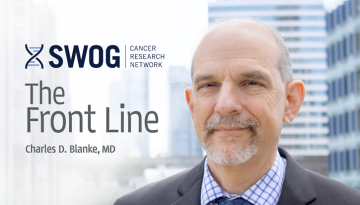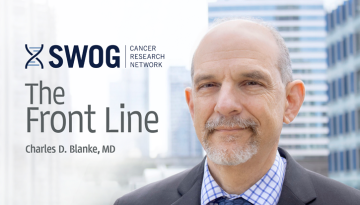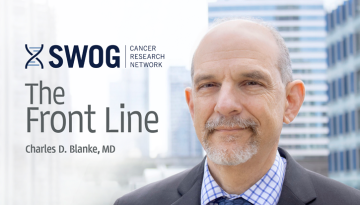In Praise of "Unknown Future Studies"
Most patients who enroll to a SWOG trial find a section toward the end of the informed consent document that asks for their permission to use their stored tissue or blood samples for "unknown future studies."
The document usually goes on to say that neither they nor their doctor will be told when research is being done using their samples, what type of research is being done, or what the outcome of that research is.
This may seem to be a lot to ask of patients who are considering enrolling in a clinical trial – a little piece of them will be saved to be analyzed or measured down the road in some way we can’t necessarily predict, and they will likely never know whether their contribution led to any new knowledge that will improve people’s health.
But great things have come from studying such samples.
SWOG researchers recently published results from one such “unknown future study” that used blood serum samples collected during the S0226 study, a trial in patients with metastatic hormone receptor-positive breast cancer.
The primary results from S0226 had shown that women with this cancer who received a combination of the endocrine therapy drugs anastrozole and fulvestrant had longer overall survival (OS) than those who got anastrozole alone.
A team led by Costanza Paoletti, MD, has found that this benefit from the combination versus the single-drug therapy was not seen in women whose blood serum showed relatively low activity of the enzyme thymidine kinase 1 (sTK1). Women with low sTK1 levels also had improved OS and progression-free survival (PFS) when compared to those with high levels of the enzyme in their serum.
These findings suggest that this blood serum test might be able to identify which patients have slow-growing disease that might be controlled with a single aromatase inhibitor drug. The researchers have called for more investigation (another unknown future study!) into whether low sTK1 levels could also identify which patients could be spared having targeted therapy added to their endocrine therapy.
Findings of this sort -- results from analyses of stored biospecimens that may have implications for future treatment decisions – are far from rare. I list below a few other results, reported over the last couple of years, from work based on samples stored in our biorepository. Note that a full list of such work would be much, much longer!
- Ryan Powles, PhD, and SWOG Breast Committee Chair Lajos Pusztai, MD, DPhil, analyzed banked samples from patients who had enrolled to the S0800 breast cancer trial. They compared whole exome sequencing results from tumor tissue taken before and after neoadjuvant chemotherapy. Their findings shed light on how some cancer cells survive neoadjuvant chemo and could help predict which patients might benefit most from the treatment.
- Priyanka Sharma, MD, and colleagues studied paraffin-embedded samples from patients who had enrolled to S9313, another breast cancer study. They analyzed the samples for a 44-gene DNA-damage response signature, and they counted stromal tumor-infiltrating lymphocytes. They found that both of these biomarkers could be used to identify which patients with triple-negative breast cancer were likely to benefit from adjuvant chemotherapy.
- Work led by Fred Hirsch, MD, PhD, on samples from two Lung-MAP trial sub-studies, associated tumor mutation burden – the rate of non-inherited mutations in a tumor’s genome – with OS in patients with non-small cell lung cancer. This work was presented at last January’s World Conference on Lung Cancer.
- Biospecimens from the CALGB/SWOG 80405 study in colorectal cancer have been used in numerous retrospective analyses, including recent work led by Heinz-Josef Lenz, MD, that found that a colorectal cancer’s consensus molecular subtype – a classification based on anatomic and genetic factors – can be both prognostic and predictive for OS and PFS.
- Samples from SWOG’s landmark S8814 breast cancer study have also been analyzed in many studies subsequent to the original trial. Wendy Woodward, MD, PhD, recently led an analysis of samples from the study that found that higher 21-gene recurrence scores were associated with increased locoregional recurrence of cancer, suggesting the recurrence score might be a useful factor in determining which patients are likely to benefit from radiation therapy. Note that it was an earlier retrospective analysis of S8814 samples that provided the initial evidence that that led to the design of SWOG’s S1007 RxPONDER study, which last year confirmed that the 21-gene recurrence score could be prognostic in certain patients with node-positive breast cancer.
Over the decades, SWOG has biobanked specimens from hundreds of trials, and our biorepository, based at Nationwide Children’s Hospital, now includes 1.13 million specimens, contributed by roughly 66,000 clinical trial participants.
We can expect to see a growing number of valuable biomarkers identified from analyses of these specimens. So the next time one of your patients asks about the “unknown future studies” section of the informed consent, tell them those studies may hold the key to the future of precision cancer treatment. And maybe even tell them about some of our examples.
Other Recent Stories



